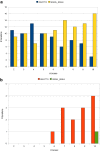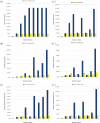Direct vs 2-stage approaches to structured motif finding
- PMID: 22908910
- PMCID: PMC3564690
- DOI: 10.1186/1748-7188-7-20
Direct vs 2-stage approaches to structured motif finding
Abstract
Background: The notion of DNA motif is a mathematical abstraction used to model regions of the DNA (known as Transcription Factor Binding Sites, or TFBSs) that are bound by a given Transcription Factor to regulate gene expression or repression. In turn, DNA structured motifs are a mathematical counterpart that models sets of TFBSs that work in concert in the gene regulations processes of higher eukaryotic organisms. Typically, a structured motif is composed of an ordered set of isolated (or simple) motifs, separated by a variable, but somewhat constrained number of "irrelevant" base-pairs. Discovering structured motifs in a set of DNA sequences is a computationally hard problem that has been addressed by a number of authors using either a direct approach, or via the preliminary identification and successive combination of simple motifs.
Results: We describe a computational tool, named SISMA, for the de-novo discovery of structured motifs in a set of DNA sequences. SISMA is an exact, enumerative algorithm, meaning that it finds all the motifs conforming to the specifications. It does so in two stages: first it discovers all the possible component simple motifs, then combines them in a way that respects the given constraints. We developed SISMA mainly with the aim of understanding the potential benefits of such a 2-stage approach w.r.t. direct methods. In fact, no 2-stage software was available for the general problem of structured motif discovery, but only a few tools that solved restricted versions of the problem. We evaluated SISMA against other published tools on a comprehensive benchmark made of both synthetic and real biological datasets. In a significant number of cases, SISMA outperformed the competitors, exhibiting a good performance also in most of the cases in which it was inferior.
Conclusions: A reflection on the results obtained lead us to conclude that a 2-stage approach can be implemented with many advantages over direct approaches. Some of these have to do with greater modularity, ease of parallelization, and the possibility to perform adaptive searches of structured motifs. As another consideration, we noted that most hard instances for SISMA were easy to detect in advance. In these cases one may initially opt for a direct method; or, as a viable alternative in most laboratories, one could run both direct and 2-stage tools in parallel, halting the computations when the first halts.
Figures





Similar articles
-
Assessment of composite motif discovery methods.BMC Bioinformatics. 2008 Feb 26;9:123. doi: 10.1186/1471-2105-9-123. BMC Bioinformatics. 2008. PMID: 18302777 Free PMC article.
-
A Monte Carlo-based framework enhances the discovery and interpretation of regulatory sequence motifs.BMC Bioinformatics. 2012 Nov 27;13:317. doi: 10.1186/1471-2105-13-317. BMC Bioinformatics. 2012. PMID: 23181585 Free PMC article.
-
Discriminative motif discovery in DNA and protein sequences using the DEME algorithm.BMC Bioinformatics. 2007 Oct 15;8:385. doi: 10.1186/1471-2105-8-385. BMC Bioinformatics. 2007. PMID: 17937785 Free PMC article.
-
Analysis of Genomic Sequence Motifs for Deciphering Transcription Factor Binding and Transcriptional Regulation in Eukaryotic Cells.Front Genet. 2016 Feb 23;7:24. doi: 10.3389/fgene.2016.00024. eCollection 2016. Front Genet. 2016. PMID: 26941778 Free PMC article. Review.
-
An algorithmic perspective of de novo cis-regulatory motif finding based on ChIP-seq data.Brief Bioinform. 2018 Sep 28;19(5):1069-1081. doi: 10.1093/bib/bbx026. Brief Bioinform. 2018. PMID: 28334268 Review.
Cited by
-
Estimating evolutionary distances between genomic sequences from spaced-word matches.Algorithms Mol Biol. 2015 Feb 11;10:5. doi: 10.1186/s13015-015-0032-x. eCollection 2015. Algorithms Mol Biol. 2015. PMID: 25685176 Free PMC article.
-
Fast and accurate phylogeny reconstruction using filtered spaced-word matches.Bioinformatics. 2017 Apr 1;33(7):971-979. doi: 10.1093/bioinformatics/btw776. Bioinformatics. 2017. PMID: 28073754 Free PMC article.
-
Alignment-free method for DNA sequence clustering using Fuzzy integral similarity.Sci Rep. 2019 Mar 6;9(1):3753. doi: 10.1038/s41598-019-40452-6. Sci Rep. 2019. PMID: 30842590 Free PMC article.
References
-
- Watson JD, Baker TA, Bell SP, Gann A, Levine M, Losick R. Molecular Biology of the Gene. 6/e: Pearson International Edition; 2007.
-
- Wray GA. The evolutionary significance of cis-regulatory mutations. Nature Rev Genet. 2007;8:206–216. - PubMed
LinkOut - more resources
Full Text Sources
Research Materials

